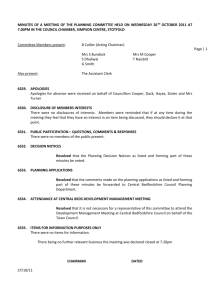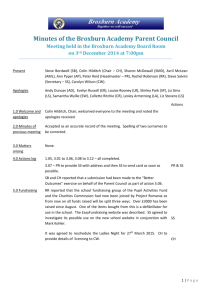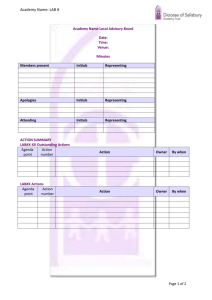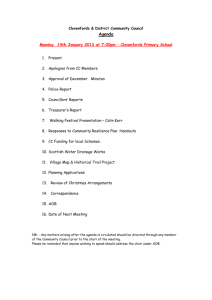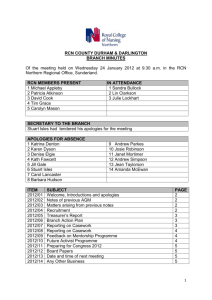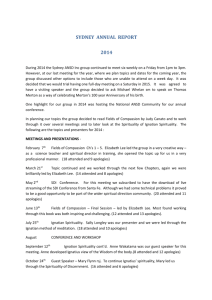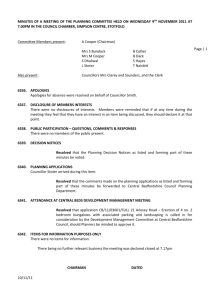Speech acts as intercultural danger zones: A corpus
advertisement
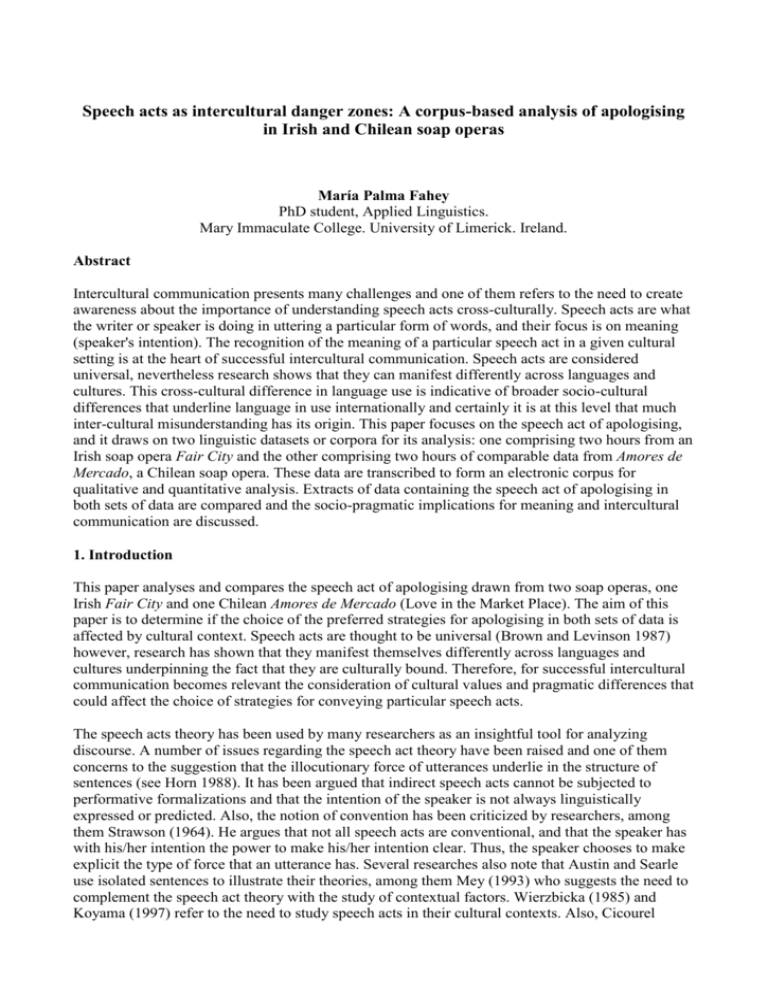
Speech acts as intercultural danger zones: A corpus-based analysis of apologising in Irish and Chilean soap operas María Palma Fahey PhD student, Applied Linguistics. Mary Immaculate College. University of Limerick. Ireland. Abstract Intercultural communication presents many challenges and one of them refers to the need to create awareness about the importance of understanding speech acts cross-culturally. Speech acts are what the writer or speaker is doing in uttering a particular form of words, and their focus is on meaning (speaker's intention). The recognition of the meaning of a particular speech act in a given cultural setting is at the heart of successful intercultural communication. Speech acts are considered universal, nevertheless research shows that they can manifest differently across languages and cultures. This cross-cultural difference in language use is indicative of broader socio-cultural differences that underline language in use internationally and certainly it is at this level that much inter-cultural misunderstanding has its origin. This paper focuses on the speech act of apologising, and it draws on two linguistic datasets or corpora for its analysis: one comprising two hours from an Irish soap opera Fair City and the other comprising two hours of comparable data from Amores de Mercado, a Chilean soap opera. These data are transcribed to form an electronic corpus for qualitative and quantitative analysis. Extracts of data containing the speech act of apologising in both sets of data are compared and the socio-pragmatic implications for meaning and intercultural communication are discussed. 1. Introduction This paper analyses and compares the speech act of apologising drawn from two soap operas, one Irish Fair City and one Chilean Amores de Mercado (Love in the Market Place). The aim of this paper is to determine if the choice of the preferred strategies for apologising in both sets of data is affected by cultural context. Speech acts are thought to be universal (Brown and Levinson 1987) however, research has shown that they manifest themselves differently across languages and cultures underpinning the fact that they are culturally bound. Therefore, for successful intercultural communication becomes relevant the consideration of cultural values and pragmatic differences that could affect the choice of strategies for conveying particular speech acts. The speech acts theory has been used by many researchers as an insightful tool for analyzing discourse. A number of issues regarding the speech act theory have been raised and one of them concerns to the suggestion that the illocutionary force of utterances underlie in the structure of sentences (see Horn 1988). It has been argued that indirect speech acts cannot be subjected to performative formalizations and that the intention of the speaker is not always linguistically expressed or predicted. Also, the notion of convention has been criticized by researchers, among them Strawson (1964). He argues that not all speech acts are conventional, and that the speaker has with his/her intention the power to make his/her intention clear. Thus, the speaker chooses to make explicit the type of force that an utterance has. Several researches also note that Austin and Searle use isolated sentences to illustrate their theories, among them Mey (1993) who suggests the need to complement the speech act theory with the study of contextual factors. Wierzbicka (1985) and Koyama (1997) refer to the need to study speech acts in their cultural contexts. Also, Cicourel (1987) maintains that Searls's analysis does not consider ethnographic conditions. According to him, cultural settings are significantly important in the overall process of understanding intention. On the other hand Croft (1994) points out the importance of considering in the analysis of speech acts not only the performance of an utterance but also the interaction of speaker and addressee. This paper consider in its analysis of apologies the social context of the speech act, and the speaker's utterances while in interaction with the addressee in the cultural space in which they are performed. At the same time, this paper makes a case for media texts to be considered as a source of relevant data for the study of speech acts. Amongst the variety of media texts available, soap operas offer represented talk appropriate of specific cultural contexts. 2. Previous Research Cross cultural studies of apologies have been carried out by many researches (Holmes 1990; BlumKulka, House and Kasper, 1989; Cohen and Olshtain, 1985, 1989). Olshtain (1989) compares apologies in four different languages using a discourse completion test (DCT). She finds common trends in the speech act of apologising across different situations. Suszczyńska (1999) analyses data drawn from a small corpus of English, Hungarian, and Polish, created from written responses to DCTs. In her analysis she highlights the differences in the realisation of apologetic responses not only in the choice and sequential arrangement of strategies but also in the content and the choice of linguistic form. Trosborg’s work (1987) refers to the importance of sociolinguistic competence. She draws her data from a corpus of 300 conversations that were elicited by means of role-plays constructed on the basis of anticipated illocutionary acts of complaints and apologies. The participants were video taped in face-to-face conversations lasting approximately five minutes. She concludes that 'sociopragmatic strategies are transferred from one language to another' (1987:153). Lipson (1994) analyses and contrasts apology strategies in American English and in Italian using the framework developed by Owen for the analysis of remedial strategies (Owen, 1983) and also Olshtain and Cohen’s semantic formulas (Olshtain and Cohen, 1983). Lipson uses an American television sitcom as an instrument for data collection. This sitcom is shown to ten Italian students who had to rewrite the respective apology episode for an appropriate Italian context. The differences between the original script and the student's versions were then analysed and compared. She finds some similarities in the remedial responses of both groups but some cultural differences in the use of subformulas (Owen's framework). Requests for forgiveness are predominate in her Italian data contrasting with the strategies preferred in English, which are the expressions of regret and the minimizing of an offence through the use of jokes and laughter. Lipson suggests that in an Italian context the expression of regret is favoured in situations when the offence is perceived as very severe by the apologiser an when greater degree of reprimanded is expected. She also asserts that the student's cultural assumptions, attitudes and expectations play an important role in their apology communication processes. Another interesting cross-cultural study is the one carried out by Márquez (2000). She contrasts apologies in British and Uruguayan contexts using role-plays to determine similarities and/or differences in the realisation patterns of apologies (and requests). Her findings confirm Blum-Kulka et al. (1989) claim that routinesed forms of apology and the strategy of expressing responsibility are present in different degrees across all situations in both languages where the rest of the apologising strategies are situation dependent. On the other hand, Meier (1998) analyses findings concerning apology behaviour in English. She compares conclusions reached on this field regarding distribution of strategies, degree of mitigation, effect of severity of the offence, effect of gender, and effect of interlocutor relationship. She asserts that the differences referring to these findings have to do with the consideration of the following variables: taxonomy of strategies, respondents and the methods of data collection. Meier recognises that although the relation between culture and language has not been ignored in the analysis of apologies, rarely language and culture have been the explicit focus of a large empirical study of this speech act. Moreover, she emphasises the importance of studying apologies considering 'values and beliefs as they inform perceptions of linguistic appropriateness' (Meier 1998: 227). 3. Apologies as speech acts Searle (1969) affirms that when we speak we are performing speech acts, acts such as .making statements, giving commands, asking questions, making promises and so on. He suggests that these acts are performed in accordance with certain rules for the use of linguistic elements (1969:16). According to Searle the goal of spoken interaction is to communicate things to the hearer by getting him/her to recognise the intention that one has to communicate those things. The speaker then must achieve the intended effect on the hearer by allowing him/her to recognise his/her intention to achieve that effect. Once the hearer recognises the intention of the speaker to achieve an effect this is generally achieved (Searle, 1969:43). Therefore, the recognition of the intention or intended meaning of the utterance (speech act) seems crucial in achieving a level of success in understanding. Nevertheless, Stubbs (1983) points out, that utterances can be wrongly interpreted and also speakers can say one thing and mean another. Because of this, it becomes crucial to consider the context in which a particular speech act is conveyed in order to understand it fully. Apology is a frequently used speech act which serves different purposes ranging from maintaining polite rituals that could vary from one society to the another (social etiquette), to the acknowledgment of serious offences. In spoken and written interactions and in effect in intercultural interactions it becomes relevant to ascertain what conditions must be present for the adequate performance of an apology. Holmes (1990:161), taking into account Austin’s (1962) and Searle’s (1969) studies on the subject, affirms that this speech act must have the following conditions: a) An act has occurred b) A believes that the act has offended B c) A takes responsibility for the act. Holmes (1990) acknowledging the importance of face (a concept originally developed by Goffman, 1967), points out that what matters most in the act of apologising is the face of the hearer. Therefore, an apology is addressed to the hearer's face need and intends to remedy an offence for which the speaker takes responsibility, and thus to restore the equilibrium between speaker and hearer, where the speaker is the apologiser, and the hearer is the person offended (Holmes, 1990:159). The goal is to restore the relationship through the acknowledgement of wrongdoing. According to Bach and Harnish (1979) in apologising to someone, either one expresses regret for what one has done or one expresses the intention that one’s utterance satisfies the social expectation to express regret (without actually expressing regret). Bach and Harnish consider that apologies fall into the category of acknowledgments because in apologising the addressee presumes he has done something regrettable to the hearer. On the other hand, Lakoff (2001) observes that apologies occur in a variety of forms ranging from the canonically explicit to the ambiguously indirect, alluding to the existence of an unambiguous apology form: ‘I apologise for eating your hamster’. Nevertheless, Lakoff states that this type of apology is unusual in very intimate contexts (2001: 201). This statement will be considered in the analysis section of this paper. 4. Apology Strategies There are a number of linguistic strategies for expressing apologies and a number of researchers have developed systems for classifying them, amongst others, Owen (1983); Cohen and Olshstain 1981; Blum-Kulka, et al, 1989; Trosborg 1987. Aijmer (1996) develops Olshstain and Cohen apology strategy system, pointing out that an apology speech act can be made on its own (e.g. lo siento, I'm sorry, I apologise) or made up of different combinations of semantic formulas. Aijmer distinguishes a total of thirteen apology strategies (1996:83) acknowledging the role that personal preference has regarding the choice of strategies. Aijmer subclassifies these strategies as explicit (direct apologies or expression of regret), implicit strategies (giving accounts, minimizing responsibility, etc) and emotional (those which express the speaker's attitude towards the situation) or non-emotional strategies: Table 4.1 Thirteen Apology Strategies (Aijmer, 1996) Explicit Emotional Explicitly apologising e.g. I apologise (for) Expressing regret e.g. I’m sorry, I’m afraid that Explicit Non-emotional Offering one’s apology e.g. I present my apologies Acknowledging a debt of apology e.g. I owe you an apology Demanding forgiveness e.g. pardon, excuse me Explicitly requesting the hearer’s forgiveness e.g. I beg your pardon Implicit Emotional Giving an explanation or account e.g. (I’m so sorry) it’s so unusual Expressing emotion e.g. oh (I’m sorry) Implicit Non-emotional Self denigration or self reproach e.g. how stupid of me, how awful Minimizing responsibility e.g. I didn’t mean to Acknowledging responsibility for the offending act e.g. that was my fault (Fraser1981: 263) Promising forbearance from a similar offending act e.g. I promise you that that will never happen again Offering redress e.g. please let me pay for the damage I’ve done Aijmer affirms that the most direct strategy is to apologise or to present, give or offer one's apologies (1996, p. 82). Direct strategies involve a high cost for speaker's face. Brown and Levinson (1987) say that the weightiness of a contemplated apology as a face threat must be calculated considering the level of intimacy and the power relationship of the parties involved as well as the seriousness of the offence (1987: 211-212). All these factors are likely to affect the choice of apology strategies. Stenström (1994) also affirms that in choosing to use an IFID (illocutionary force indicating device, which contains the formulaic routinesed forms of apology such as: I apologise; sorry) as the explicit expression of an apology, the speaker accepts the need to apologise and assumes the cost to do so. This cost refers to the cost of losing face in public since an apology might imply guilt on the speaker’s part. At the same time Stenström suggests that not making a necessary apology may occasion more serious face loss in the long run (idem: 211). 5. Data This paper analyses data drawn from two linguistic corpora one comprising two hours of an Irish soap opera Fair City and the other comprising two hours of comparable data from Amores de Mercado, a Chilean soap opera. Episodes from both soap opera where randomly recorded between the years 2001 and 2002 (Amores de Mercado only lasted 6 months and was broadcast in Chile in the year 2001). The data taken from both soap operas has been transcribed to form an electronic corpus of 50,000 words to be used for qualitative and quantitative analysis. The dialogues that form part of the data have been created by teams of scriptwriters and enacted by professional actors. 6. Method The limitations regarding the study of speech acts in general, and in particular the study of the speech act of apologising, refer principally to the method of gathering significant data. Among the methods have been often used to elicit relevant data in the field of pragmatics and intercultural communication are the following: discourse completion tasks and questionnaires (DCTs), recall protocols, role- plays, field observations and recording of naturally occurring talk in interaction. All of these methods have their advantages and disadvantages (see Golato, 2003), and by far the ideal method for comparing speech acts in two or more languages is the recording of naturally occurring talk in interaction. The data gathered through this method consist of non-elicited, audio-taped or video-taped face to face encounters and/or audio taped spontaneous telephone conversations. Nevertheless, one of the disadvantages of the use of this method is the gathering of sufficient data of a specific speech act that the researcher wants to investigate. Apologies for instance, due to the fact that they appear to be context dependent, are very hard to record as natural talk. Another disadvantage is the difficulty in controlling variables such as power, status, gender and age difference between the participants. On the other hand, the use of soap operas is considered in this paper to be a suitable source of data. Some of the advantages of using data drawn form soap operas are the following: soap operas are accessible and the quality of sound and recording is often good. In soap operas the context is made explicit for the researcher because they are designed to be observed and ratified by an observer (i.e. audience). Among the disadvantages of using soap operas as a source of data are the following: they are artificially scripted, and an observer needs to watch several episodes to gain contextual information (e.g. knowledge of the characters' personalities, their relationships and roles). However, soap operas present apologies and other speech acts, which have been carefully crafted in order to appear as spontaneous speech, allowing at the same time the observation of pragmatic elements of a particular culture. They present scripted conversation as real conversation and the significance of the dialogues is entirely dependent on context. The actors enact the dialogues and try to replicate the spontaneity of real speech, and most times viewers of soap operas perceive the language used as casual conversation. It could be argued that the soap opera dialogues cannot represent casual spoken language because they are not spontaneous. Nevertheless, the level of engagement of the audiences with a particular soap opera (as the ones being analysed in this paper) seems to demonstrate that they are perceived as representative of real dialogues. Moreover, soap operas are geographically situated and their linguistic and pragmatics differences allow their audiences to recognise them as their own. In this paper a data base of all speech acts was compiled based on manually reading all of the transcripts. These categorisations were then cross-checked by two independent researchers. For this study, scenes that contain the speech act of apologising were isolated and then analysed according to Aijmer’s framework of apology strategies (1996), which is based on Olshtain and Cohen framework (1993). This framework allows a detailed cross-cultural comparison of apologies. A total of 37 apologies were found in the Irish data and a total of 28 apologies in the Chilean data. These apologies were also analysed and compared according to the following variables: type of apology, type of offence (serious or trivial), power relationship between hearer and speaker (symmetrical or asymmetrical), social distance, settings and the use of vocatives and intensifiers (additional linguistic markers). The outcome of the apologies has also been considered. The sociopragmatic implications for meaning and intercultural communication are discussed below. 7. Analysis Aijmer (1996) suggests the classification of apologies conveyed in discourse into two major groups: anticipatory apologies which function is disarming and retrospective apologies which function is remedial. Table 7.1 Overall classification of apologies Total number of apologies Fair City Amores de Mercado 37 Percentage 28 Percentage Disarming (anticipate an offence) 12 32% 17 61% Remedial (response to an offence) 25 68% 11 39% Type of Apology 7.1 Disarming apologies Disarming apologies are those apologies that anticipate an offence and they are often issued in both sets of data before formulating a question, asking for repetition of what has been said or before making a statement that is contrary to the one already formulated by the speaker. Edmondson (1981) asserts that disarming apologies are issued before a speech act that could be considered by the speaker inconvenient for the hearer or contrary to the hearer's views. These apologies play an important politeness role because they soften the threat to face and aim to maintain harmony with the hearer. In Amores de Mercado most apologies are disarming 61% compared to 32% in Fair City. This high percentage in the number of disarming apologies in the Chilean data reflects the degree of sensitive towards politeness present in the Chilean culture and the importance given to the consideration of the hearer's face and also the speaker's own face. Disarming apologies are often easier to convey than remedial apologies because the latter involves a higher cost of face for the speaker. Disarmer apologies found in data refer to the following types of offence shown in table 7.2. Table 7.2 Type of offences (Holmes 1990) and overall total of disarming apologies Offence Fair City Amores de Mercado Asking 8% (1) 35% (6) Repetition/ Clarification 25% (3) 6% (1) Asking for turn 8% (1) 0 Total= 42% Total= 41% Total= 8% (1) 0 Impoliteness 8% (1) 35% (6) Length of meeting 8% (1) 0 Leaving the room 25% (3) 6% (1) Interrupting 8% (1) 18% (3) Total= 50% Total= 59% Talk: Violation of space Inconvenience: 0 Possession (damaging property) 0 In both sets of data most disarming apologies are conveyed before inconvenience offences (50% Fair City and 59% Amores de Mercado) such as apologising before giving an opinion that could annoy or upset the hearer; leaving a room and interrupting. Disarming apologies that refer to talk offences amount to 42% in Fair City and 41% in Amores de Mercado. Table 7.3 Disarming apology strategies used in Fair City Sorry 10 (83%) Excuse (me/us) 2 (17%) The preferred strategy for conveying disarmer apologies in the Irish data is the use of an explicit expression of regret: sorry. Excuse me was conveyed as a disarming apology before making a statement contrary to the one formulated by the speaker. Excuse us was used to apologise for an inconvenience offence (leaving the room). In extract 1, speaker 1 apologises for an inconvenience regarding time that a meeting with a particular client will cause the hearer: 1) <$1> Sorry this probably will take a couple of hours. <$2> Really? <$1> It’s Fergus. <$2> Oh my condolences. <$1> Yeah well we need all the clients we can get Donald. Table 7.4 Disarming apology strategies used in Amores de Mercado Perdón (Pardon, Excuse) 35% (6) Perdonar (Verb to forgive) 29% (5) Disculpar (Verb to apologise) 29% (5) I'm sorry 6% (1) In the Chilean data several strategies have been chosen to convey disarming apologies: perdón (pardon) is used mostly to anticipate talk offences when asking for clarification or repetition of what has been said; verbal forms of perdonar (asking to be forgiven) and disculpar (to apologise) are used in situations in which the speaker suspects that his/her action will be inconvenient for the hearer. There is also one disarming apology conveyed in English (I'm sorry) by a character (a butler) who uses code switching to assert his membership to an educated social class. In extract 2, the hearer's negative face is acknowledged by speaker 1 who wants to ask speaker 2 an intimate question: 2) <$1> Oiga señora Maitén eh dísculpeme que yo me meta ah pero ¿le puedo hacer una pregunta? <$2> Mm. <$1> ¿Por qué usted sigue con su marido? O sea me refiero después de todos estos años <$X> po | pues<\$X>. <$1> Listen Ms. Maitén eh forgive me for intruding ah but can I ask you a question? <$2> Mm. <$1> 'Why are you still with your husband? Well I mean after all these years'. 7.2 Remedial apologies Remedial apologies are those apologies that are uttered after an offence has been committed. They are retrospective, supportive of the hearer and self-demeaning (Aijmer, 1996: 99). The apologiser's main concern is the reestablishment of harmony with the hearer. In Fair City 68% of the apologies are remedial compared to 39% in Amores de Mercado. The choice of a particular strategy or combination of strategies for conveying remedial apology supposes the consideration of the following variables: seriousness of the offence, relationship of power between the participants, and the consideration of setting. The following table shows the findings regarding types of offences in both sets of data: Table 7.5 Type of offences: remedial apologies Type of offence Fair City Amores de Mercado Inconvenience (Social behaviour, Impoliteness) 92% (23) 82% (9) Time offence (Arriving late) 8% (2) 9% (1) Possession 0 9% (1) In both sets of data most of the offences refer to social behaviour and impoliteness. There is only one offence that falls into the category of possession (damaging personal possession) and refers to a situation in which a butler tears his employer's wedding dress. Table 7.6 Remedial apologies: list of offences Fair City Amores de Mercado Serious Serious Being a bad father 2 Searching for information in boss's private file 2 Getting angry with friend 2 Ruining mother's plans 1 Breaching confidentiality 2 Saying the wrong thing 1 Saying the wrong thing 3 Not being a good mother 1 Not telling mother about relationship 1 Being too demanding 1 Intruding in personal life 1 Criticising business practice 1 Being a bad friend 2 Tearing wedding dress 1 Failed love relationship 1 Upsetting friend 1 Total= 60% Total= 72% Casual Casual Inconvenience 2 Looking at employer's legs 1 Saying the wrong thing 2 Asking the wrong question 1 False pretences 1 Being late 1 Hurting (massage) 1 Being snappy 1 Being late 2 Being upset (crying) 1 In this paper Total=40% Total=27% the rating of the offences as serious or trivial has been determined taking into consideration the context in which the offence took place. Consequently, in both soap operas most offences are considered serious because they imply a high cost of face for the person offended and also a high cost for the apologiser. These serious offences refer to social behaviour and impoliteness. After the offence has been committed the apologiser tries through the conveyance of the speech act to restore the relationship with the hearer, and at the same time, conveys his/her support for the hearer's face. Casual offences in Fair City refer to situations in which the participants have a close social distance and they feel more at ease with each other. In Amores de Mercado, asking the wrong question to a friend is considered a casual offence if the relationship between them is close (social distance). Looking at the employer's legs is considered a casual offence in the given context of the scene, because of the complex relationship (flirtatious at times) sustained between the two parties, a butler and his employer. Offences referring to time are considered to be casual in both sets of data. 7.3 Power Relationship The power relationship between two people is considered symmetrical in this paper if both, hearer and speaker seem to have the same social power in the given context of the scene. The relationship is considered asymmetrical if there is an imbalance of power. Table 7.7 Power relationship in Fair City and Amores de Mercado Fair city Amores de Mercado Symmetrical 100% (37) 50% (14) Asymmetrical 0 50% (14) In Fair City all the spoken interactions in which apologies are present are considered symmetrical because the parties involved have the same power to interact as socially equals in the given contexts. The cost of face involved for the speaker in the act of apologising is based mainly in the consideration of the seriousness of the offence and the importance given to the relationship and not in the consideration of work status or social class. On the other hand, in Amores de Mercado the power relationship was considered asymmetrical in 50% of all instances in which apologies were offered and 50% asymmetrical. The presence in the Chilean soap opera of numerous asymmetrical relationships reflects aspects of the contemporary Chilean society, where a great deal of importance is given to social status and social distance at work. In these cultural contexts, apologies remedial and disarming are sought and expected, and both types of apologies can present a high cost of face for the speaker. In Fair City the majority of apologies are offered to friends and partners (22% and 38% respectively). Most apologies presented to friends and partners are remedial. On the other hand, in Amores de Mercado most apologies are offered to superiors at work (employer or direct boss, 33%) and they are almost evenly divided between remedial and disarming apologies. Apologies offered to friends, family, acquaintances and ex-friends share second place in the overall total (18% respectively). In Amores de Mercado apologies issued to acquaintances and ex-friends have the second highest number of disarming apologies (18% respectively). 7.4 Setting Setting is considered to be important in this analysis because it allows the understanding of the physical context in which apologies are issued. Settings can affect the choice of apology strategies and also the weight of an apology. In the context of soap opera settings can be divided into private and public places. In the Irish data most apologies take place in houses (32%) and in the pub (27%), followed by apologies presented in the street (14%). In the Chilean data the house is the preferred place to present an apology (50%). The office is the second preferred place (18%) followed by other work places: clinic, nightclub and market. In Amores de Mercado 33% of the apologies are presented at work compared to 8% in Fair City. In Fair City 59% apologies are offered in public areas (pub, street, mountain, bistro/café and restaurant) compared to 12% in Amores de Mercado (bistro/café, restaurant and bus). In Amores de Mercado the Irish pub culture as a way of everyday socializing is almost non-existent in Chilean society. 7.5 Apology strategies The comparative analysis of the use of apology strategies indicates the following differences as graph 7.1 shows: Graph 7.1 Apology strategies used in Fair City and Amores de Mercado (remedial apologies) As it can be seen in the graph above the choice of a particular main strategy (or combination of strategies) varies in both sets of data. a) Expressing regret The expression of regret: I'm sorry or sorry, is the main apology strategy used in Fair City for conveying remedial apologies. It is culturally bound and it is speaker centred. In extract 3, speaker 1 explicitly expresses his regret for having said something that offended the hearer (his mother): 3) <$1> I’m sorry that’s not what I meant <$E2> sighs <\$E2> I was thinking of you driving clapped out cars for Leo Dowling while while that toe rags is probably over in Birmingham driving around in a B M W. The choice of this strategy contrasts with the preferred strategy drawn from the Chilean data as it can be seen below. b) Explicit strategies used in Amores de Mercado In Amores de Mercado the main apology for conveying a remedial apology is an explicit strategy: explicitly apologising (36%), demanding forgiveness (45%), explicitly requesting the hearer's forgiveness (9%), offering one's apology (9%). It is essential to acknowledge that in Chilean Spanish there are different strategies that can be used for explicitly conveying remedial apologies: te pido disculpas, dísculpame (I apologise), perdóname, (forgive me), te pido perdón (I ask your forgiveness). There are also verbal forms that allow the expression of regret: lo siento (I'm sorry), siento mucho (I'm very sorry), lamento (I regret). In Amores de Mercado the direct explicit types of apologies are preferred, using the verbal formulae equivalent to: excuse me, forgive me. This type of apology is hearer orientated because places on the recipient the burden of granting forgiveness. It implies a high cost of face for the speaker and acknowledges the positive face of the hearer. The overall goal is to restore and/or maintain the relationship, as can be seen in the extract 4 in which speaker 1 apologises for arriving late: 4) <$1> Hola disculpa el atraso. ¿Llevas mucho rato esperándome? <$1> 'Hi excuse the delay. Have you been waiting a long time for me?' The expression of regret is also possible and valid as an apology strategy in a Chilean context, e.g.: lo siento, lo siento mucho (mucho used here as an intensifier). Nevertheless, this strategy, even though it allows the speaker the acknowledgment that something is wrong, does not necessarily convey the intention that the speaker feels responsible for any wrongdoing. And therefore, in order to support the hearer (his/her's positive face) it is usually accompanied by other strategies, as it is also the case in the Irish data. Culturally this type of apology is not favoured in the Chilean context, and consequently the Chilean soap opera Amores de Mercado is mirroring this general cultural preference. c) Acknowledgment of responsibility for wrongdoing This strategy is present in 24 % of all remedial apologies in the Irish data and only in 12% in the Chilean data. d) Giving an explanation or account Explanations or accounts are giving in 44% of all remedial apologies in Fair City compared to 18% in Amores de Mercado. Explanations seem to be needed to support the strategy of regret, which is the preferred strategy in the Irish data. e) Self-reproach This strategy is only found in the Irish data (8%) and aims to boost hearer's positive face. f) Minimizing responsibility In Amores de Mercado this strategy is used in 4% of remedial apologies compared to 16% in Fair City. The strategy of minimizing responsibility brings down the high cost of face that the act of apologising has for the speaker. g) Offering redress In Fair city redress is offered in two occasions (8%), in situations that refer to serious offences. h) Promising forbearance The strategy of promising forbearance is present only in one instance in Amores de Mercado (9%) and Fair City (4%). In both situations the offences are serious and they involve a high cost of face for the apologiser (Fair City: breaching partner's confidentiality; Amores de Mercado: searching for information in boss's private file). 7.6 Outcome of the apologies Serious offences often demand the use of a combination of strategies, taking also into account the participants' social distance. The storylines of a particular soap opera determine the length of the process involved in the offering and acceptance of an apology. Apologies are only dismissed in data drawn from Fair City 28%. Offences are forgiven 91% in Amores de Mercado compared to 60% in Fair City. Relationships are restored in 45% of the data drawn from Amores de Mercado, compared to 8% in Fair City. 7.7 Additional linguistic markers Vocatives and intensifiers are acknowledged in this paper because they seem to perform an important role in the conveyance of an apology, and also because of their frequency in both sets of data. Table 7.8 Overall total of additional linguistic markers: vocatives and intensifiers Fair City Amores de Mercado Vocatives 24% 47% Intensifiers 16% 7% 7.7.1 Vocatives The vocatives that accompany apology strategies in both sets of data are used as mitigators to soften a potential threat to positive or negative face (FTAs) (McCarthy and O'Keeffe, 2003). Vocatives also help to signal and to maintain the power relationships and/or social distance between the participants. In Fair City, first names are used as mitigators of face-threats (100% of instances in which apologies are accompanied by a vocative) as in extract 5: 5) <$2> I’m sorry Annette I’m just really having one of those days it just started all badly and just went down hill from there two jobs interviews today any luck but I what do you think? <$1> Something will turn up. In Amores de Mercado first names are used (on their own) as part of an apology strategy in 11% of instances. They are also mitigators as is shown in extract 6 (disarming apology): 6) <$1> Perdona Myri ¿qué estái (estás) diciendo? '<$1> Excuse me Myri. What are you saying?' Myiri is a shortened version of the full name Myriam, and it is used here to convey closeness. In Amores de Mercado titles are used 32% of all instances to emphasise social distance and to mark the power relationship existent between hearer and speaker. Titles are also used to signal respect (politeness), i.e.: Don, Señora, Doña. McCarthy and O'Keeffe (2003) affirm (citing Jaworsky and Galasiński, 2003) that 'the speaker does not use the vocative to attract the attention of his addressee, but to define the interpersonal space between them'. This can be seen in extract 7 in which the use of vocative facilitates the maintenance of a social relationship already established between speaker 2 (a butler) and the hearer (his employer): 7) <$2> No no no señora Morgana. Por favor por favor no me despida por favor yo yo no podría vivir lejos de usted. Por favor señora Morgana. 'Please Misses Morgana. Please please don't fire me please. I I wouldn't be able to live far away from you. Please Misses Morgana' Kinship terms: mamá and papi are used 7% in Amores de Mercado and they are not present in the Irish data. Kinship terms also mark the social distance existent between the participants, emphasising closeness 7. 7.2 Intensifiers Intensifiers are considered in this analysis because of their importance in relation to recipient's positive face and sender's positive face needs (Browne and Levinson, 1987). And also because they are present in 16% of the total data drawn from the Irish soap opera. Leech (1983) emphasises the association of intensifiers with positive politeness as they convey the sincerity of the speaker. Aijmer (1996) affirms that without the use of intensifiers apologies are neutral. Nevertheless, her findings refer to data drawn from English language corpora. Table 7.9 Intensifiers used in Fair City Really 10% Truly 3% So 3% In the Irish data the presence of intensifiers is associated with the main apology strategy preferred, which is the expression of regret. Most intensifiers, with one exception, are accompanying remedial apologies referring to serious offences, and their presence emphasises the contrition of the speaker. They also help to signal the importance that the speaker gives to the restoration of the relationship. In the only disarming apology in which an intensifier (really) is used the speaker is trying to soften with it the potential threat to face that his next action presents to the hearer (removing himself from a situation that it is becoming too intimate). In extract 8 speaker 1 apologises for abandoning the hearer and their children. The intensifier is used to emphasise the speaker's sincerity: 8) <$1> Tess I’m truly sorry. In extract 9 speaker 2 apologises for his unpleasant behaviour during the last encounter that he had with hearer: 9) <$2> Listen hang on a second Dolores <$E2> sighs <$\E2> look I’m really sorry about what happened last week mm it got a bit heavy and I was out of order I’m really sorry. Table 7.10 Intensifiers used in Amores de Mercado En serio (really) 4% Please 4% In Amores de Mercado intensifiers are present only in two remedial apologies (7%). This outcome refers to the fact that the preferred apology strategies in the Chilean data are explicit and direct and they do involve the contrition of the speaker. In Amores de Mercado intensifiers are used to strengthen even more the force of the apology, as it is shown in extract 10 in which a daughter (speaker 2) apologises to her mother for ruining her wedding plans: 10) <$2> Bueno mire sea como sea eh le pido perdón mm en serio. 'Well, look whatever it may be I ask you sincerely for your forgiveness'. 8. Conclusion The main finding of this paper refers to differences regarding the preferred apology strategies in both sets of data. In the Irish data the expression of regret is the favoured apology strategy. This strategy in the Chilean context does not have the same value as it does in the Irish context. In the Chilean soap opera the use of verbs that formulaically and directly demand forgiveness or express an apology are the preferred strategies. On the other hand, the conveyance of an explicitly direct apology strategy using an apologising verb is considered to be rather formal in an Irish context. At the same time, the acknowledgement of wrongdoing is a strategy used frequently in the Irish context and combines with the expression of regret. Thus, the expression of regret on its own, especially in the case of serious offences, is not always appropriate to express the necessary contrition culturally needed for apologising, The use of intensifiers in apologies drawn from Fair City manifests the need to emphasise the sincerity of the speaker and his/her feeling of regret regarding the offence. The analysis of both sets of data shows that there are important cultural differences regarding: a) settings in which apologies are conveyed, i.e. the generalised Irish pub culture does not exist in the Chilean context, b) social distance of the participants, and c) power relationships established between hearers and speakers. The combination of three factors affects the need that a speaker has for restoring a relationship. In the Chilean data great importance is given to the acknowledgement of social distance through the use of vocatives and explicit apology strategies. The seriousness of the offence also appears to be related to social distance. Overall the limited results of the cross cultural analysis of apologies presented in this paper highlight the need: a) for more corpus based research, whether of media texts or of spontaneous spoken data, b) the problems which may arise when transferring speech acts from one language to another, c) the difficulty in translating utterances without considering the specific context in which they were delivered. On a broader level it is important to emphasis that intercultural communication is more than choosing a language to interact and the knowledge of how different languages work formally and substantively. Research is proving the importance of creating awareness of explicit and implicit cultural differences in order to understand the pragmatic meaning of speech acts in any given language. Moreover, the importance of recognising cultural contexts of speech is becoming apparent, in order to pre-empt cross-cultural pragmatic failure. References Aijmer, K. (1996). Conversational Routines in English. London: Longman. Austin, J. (1962). How to Do Things with Words. Oxford: Oxford University Press. Bach, K., Harnish, R., (1979). Linguistic Communication and Speech Acts. Cambridge: The Massachusetts Institute of Technology. Blum-Kulka, S., House, J., Kasper, G. (eds.), (1989). Cross-cultural Pragmatics: Requests and Apologies. Norwood, NJ: Ablex. Brown, P., Levinson, S., (1987). Politeness: Some Universal in Language Usage. Cambridge: Cambridge University Press. Carter, R. and McCarthy. M. In press. Cambridge Advance Grammar of English. Cicourel, A. (1987). 'Oh John R. Searle's intentionality'. Review article. Journal of Pragmatics 11: 641-660. Croft, W. (1994). 'Speech act classification, language typology and cognition'. In S. Tsohatzidis (ed.) Foundations of Speech Act Theory: Philosophical and Linguistic Perspectives. London: Routledge, 460-477. Holmes, J. (1990). ‘Apologies in New Zealand English’. Language in Society, 19 (2): 155-99. Horn, L. (1998). 'Pragmatic theory'. In F. Newmeyer (ed.), Linguistics: The Cambridge Survey. Vol.1 Linguistic Theory: Foundations. Cambridge: Cambridge University Press, 113-145. Goffman, E., (1967). Interaction Ritual: Essays on Face-to Face Behaviour. New York: Anchor Books. Golato, A., (2003). 'Studying compliment responses: A comparison of DCTs and recordings of naturally occurring talk'. Applied Linguistics 21(1): 90-121. Koyama, W. (1997). 'Desemanticizing pragmatics'. Journal of Pragmatics 28:1-28. Lakoff, R. (2001). 'Nine ways of looking at apologies: the necessity for interdisciplinary theory and method in discourse analysis'. In Schiffrin, D., Tannen, D. and H. E. Hamilton (eds.) The Handbook of Discourse Analysis. Oxford: Blackwell. Lipson, M. (1994). ‘Apologizing in Italian and English’. International Review of Applied Linguistics in Language Teaching, 32 (1): 19-39. Márquez, R., R., (2000). Linguistic Politeness in Britain and Uruguay. Amsterdam: John Benjamins. Marshall, J. Werndly, A., (2002). The Language of Television. London: Routledge. McCarthy M. and O'Keeffe A., (2003). '"What's in a name?": Vocatives in casual conversations and Radio Phone-in Calls'. In Leistyna P. and Meyer Ch. (eds.) Corpus Analysis: Language Structure and Language Use. Amsterdam: Rodopi. Mey, J. (1993). Pragmatics. An Introduction. Oxford: Blackwell. Olshtain, E. (1989). ‘Apologies across languages’. In Blum-Kulka, S., J. house, G. Kasper and R. Freedle (eds.). Cross-cultural Pragmatics: Requests and Apologies. Norwood, NJ: Ablex, IX: 155173. Olshtain, E. and Cohen, A. (1989). ‘Speech act behaviour across languages’. In Dechert, H. and R. Manfred (eds.). Transfer in Language Production. Norwood, NJ : Ablex, XVII: 53-67. Owen, M. (1983). Apologies and Remedial Interchanges. A study of Language Use in Social Interaction. Berlin: Mouton. Searle, J. (1969). An Essay in the Philosophy of Language. Cambridge: Cambridge University Press. Searle, J. (1976). ‘The classification of illocutionary acts’. Language in Society 5, 1-24. Stenström, A-B. (1994). An introduction to Spoken Interaction. London: Longman. Stubbs, M., (1983). Discourse Analysis. The Sociolinguistic Analysis of Natural Language. Oxford: Blackwell. Suszczyńska, M., (1999). ‘Apologizing in English, Polish and Hungarian: different languages, different strategies’. Journal of Pragmatics, 31, 1053-1065. Trosborg, A. (1987). ‘Apology strategies in natives/non-natives.’ Journal of Pragmatics, 11 (1): 147-167. Wierzbicka, A. (1985). 'Different cultures, different languages, different speech acts. Journal of Pragmatics, 9: 145-178. María Palma Fahey PhD student, Applied Linguistics. Mary Immaculate College. University of Limerick. Ireland. Intercultural Communication, ISSN 1404-1634, 2005, issue 8. Editor: Prof. Jens Allwood URL: http://www.immi.se/intercultural/.

